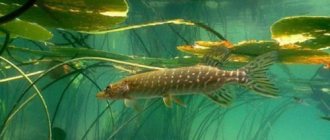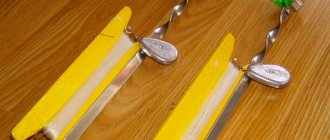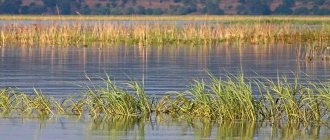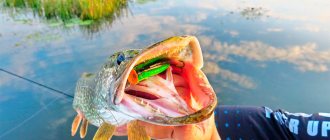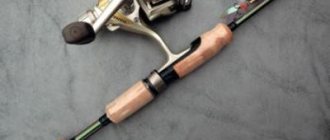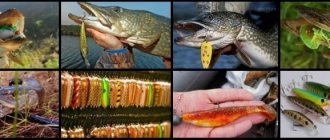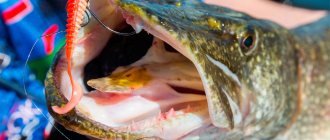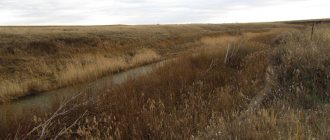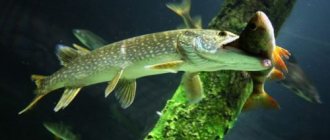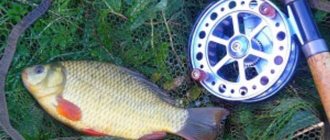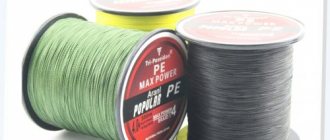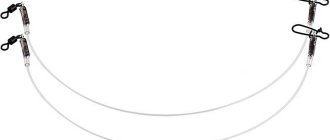Length
An important parameter that needs to be taken into account when buying or making leashes for pike fishing is their length. Here you need to be guided by two criteria:
- The longer the spinning rod leashes, the more they influence the bait’s own performance.
- The shorter they are, the greater the likelihood of cutting the wobbler or spoon with pike teeth.
The leash for a spinning rod when using a rotating spoon can be placed very long, because the wiring of this bait is straightforward and the leash insert does not have much influence on it.
Selection rules
When fishing with a spinning rod, do not get carried away with long leashes; frequent overlaps are possible. A length of 8 cm is quite enough. Strength is of great importance. If you are going after trophy specimens, it is better to use titanium tackle. Yes, it is expensive, but it is strong and durable. However, any tackle of this kind can serve well if the storage and transportation conditions are followed.
Pay attention to the swivel and fastening rings. All this must be secured securely.
Varieties
All leashes are divided according to two main criteria: the manufacturing method and the material used for this.
If in the first case we can either buy a product in a store or make a leash for a pike with our own hands, then the choice of material for its manufacture is very extensive:
- Steel wire. You can buy and make it yourself from a strand of telephone field wire, for example.
- Copper wire. Classic guitar strings have long been used by amateur fishermen to make leashes.
- Tungsten and titanium. Products made from these metals are gaining increasing popularity among spinning anglers due to their small thickness and virtually no line memory.
- Double thick vein braid. Such products are easy to make yourself, and directly while fishing. Large diameter monofilament and braided fishing lines are used.
- Leading material. It is also easy to make protective inserts from pike teeth. Moreover, in their manufacture it is also necessary to use various crimps.
- Kevlar leashes. Quite soft and durable material, but a large pike can handle it.
- Fluorocarbon leaders are available in stores, and you can easily tie them yourself using appropriate fishing line. The diameter of fluorocarbon for these purposes is from 0.5 millimeters.
Let's look at the advantages and disadvantages of various leader materials.
The best leashes for pike fishing
August 2, 2021 Yuran
Will there be something radically new in “anti-pike” leashes? Maybe completely invisible models have already been invented, while the sharp teeth of a predator will have no chance of chewing them through? Are there special leashes with which you won’t lose in the number of bites compared to leadless rigs? I will express my opinion based on sales of ready-made leashes and leash materials.
So far there are no revolutionary trends indicating the creation of products from a radically new material. Evolution is taking place in two main directions.
The first is fluorocarbon, which is truly practically invisible to fish in water and is more or less resistant to the sharpest pike teeth. That is why it continues to gain popularity, especially when fishing in clear water, which is most typical for late autumn fishing and the winter betting season. And of course, in spinning, especially when the thinnest braids are used, which the pike cuts off with its mouth at once.
From time to time she also cuts fluorocarbon leashes, but this still happens much less often. In addition, this material “separates” the bait from the clearly visible braid, which is essential when catching perch and predatory whitefish. In general, fluorocarbon is steadily popular, improving in its qualities, and has begun to be sold not only on reels, but also in the form of completely finished leashes - of different lengths, with already attached fasteners, swivels of various sizes.
[THERE IS AN ANSWER] How to catch pike with a spinning rod from the shore
The second direction also remains unchanged for now - elastic metal multi-strand “cables”, the loops of which are fixed with the supplied clips. Or the ready-made leashes of different lengths and diameters offered - to suit the personal tastes of anglers and the need for something specific in specific fishing conditions dictate diversity here.
By the way, about the thickness of the leash, where the picture is similar to fishing lines: specific brands can freely “play” with the diameter. Let's say, two different models are positioned with the same number of threads and a similar breaking load, but the branded item will have a real diameter of 0.26mm, the second Chinese one will have 0.38mm. This can be seen by eye and by touch, but if there is no comparative experience, then it is more reliable to check with a micrometer, like the same fishing line.
As for the color of the pike metal leash. In my opinion, this point is at the very end of the other properties of good tackle, although it cannot be discounted. The black color is not bad in muddy water, when fishing on the same black bottom, on the same flooded peat bogs. There are also silver leashes, but they are considered optimal only for sea fishing. The most common color on sale is dark brown; it is good in a variety of conditions and is considered universal by many anglers.
The question of choosing the length of the leash is more important when you want to make a balanced rig so that it gives a good percentage of realized bites, and so that a particularly toothy pike does not chew through it. There are no guarantees here. Let’s say, if you leave live bait fishing gear unattended for a long time, then a toothy fish weighing 6-8 kg will swallow a 50-centimeter leash almost completely without any problems, and can easily bite the fishing line. And this is very unpleasant.
But this is not a reason to increase the length of the metal leash to a meter, thereby significantly coarsening all the gear, and the most popular lengths for live bait gear in winter and summer are from 30 to 40 cm, depending on the mass of the hunted object. But they make it longer from fluorocarbon. I had to meet fishermen who had similar leashes in the area of a meter. But for spinning the most popular ones are 20-25cm.
Published in the section Important little things
This method is universal for all types of materials from fluorocarbon fishing line to field cable core. It is possible to use a running knot or a figure eight knot.
Double thick line
This is the most affordable material for making leashes. But you shouldn’t make leashes for spinning rods out of it. It is best to use fishing line to make double leashes for pike rigs. After all, in winter the pike is picky and cautious, so it is undesirable to put metal on it because of its visibility, and fluorocarbon because it is inappropriate to spend money on expensive material.
When using leader lines, you should use veins with a diameter of at least 0.4 millimeters.
The creation of such a leash must certainly be done in the following sequence:
- We knit one vein to the ring of a hook or tee using a “Clinch” knot or similar.
- We tie the second vein to the ring with the same knot.
- We twist the veins into a pigtail.
- At the opposite end of the braid we attach a winding ring.
Now, even if a pike’s teeth bite through one of the veins, the predator can be removed to the second.
Steel and copper wire
Metal wire leashes have several qualities that both positively and negatively affect their manufacture and use:
- The thickness of the wire is minimal, which means it practically does not scare the predator.
- The wire is very rigid, therefore it has low wear resistance and good memory.
- The availability and low cost of wire makes it one of the leaders in the budget class.
- It is rare that a pike is able to bite through a freshly placed wire leash.
In addition to the fact that wire products can be purchased at almost any fishing store, they are easy to make with your own hands. Typically, the first or second guitar strings or a core from a field telephone cable are used for these purposes:
- We fold a loop at the end of the steel vein and fix it with a couple of turns around its axis.
- At the other end we make exactly the same loop, but twist the tip of the vein in the opposite direction.
- We insert a hook into the chuck of a drill or screwdriver, and screw the second hook into some kind of wooden object (meaning hooks for hanging chandeliers, etc.).
- Turn on the drill for slow rotation.
At the ends of the wire you get two neat loops with even winding.
The role of the leash and its characteristics
Fishing with or without a leash is a personal choice for each angler. For some, a leash is a necessary element in the equipment of a fishing rod, for others it is an extra element.
What is the main role of a leash? It exactly imitates the behavior of a small fish, which the predator is targeting. The leash moves freely in the water column, which cannot be said about a fishing line weighed down with a sinker. Speaking about pike jaws, it should be mentioned that it is much more difficult to bite through a leash, since metal is often used to make it. Considering these factors, you can decide for yourself: you need a leash or it’s better to do without it.
If fishing with a leader is preferable, then you need to know a thing or two about line length. The optimal leash length is 15–20 cm. Why? Pike most often attacks the bait from the side. Taking a running start, the fish often misses. Thus, the long length of the leash ensures that the predator does not accidentally gnaw the fishing line instead of the leash. Also, if the fish attacks the bait from below, it will not be able to swallow it enough to bite the main line. Longer leashes (20–30 cm) can be used for trolling; in other cases, shorter leashes are used to avoid overlap with the main line.
Titanium and tungsten
These materials are soft and allow the bait to play well. Their disadvantage is that numerous postings and bites greatly affect their geometry. Simply put, leashes quickly twist into unnatural shapes.
Such products are not made with your own hands due to the rarity of materials on sale. It should also be noted that leashes made from these materials are relatively expensive.
Leading material
This is a braid made of numerous thin steel veins covered with a thin shell. Sold in unwinds and is a valuable material for making homemade leashes.
Leashes made from this material have a small diameter and are easy to knit both at home and in a combat situation on the shore of a reservoir. By the way, a fluorocarbon leader is made in the same way.
- We cut off the required piece from the bobbin, remembering that we need a piece ten centimeters larger than the required length of the future leash.
- We put two crimping tubes on a piece of leash material.
- At the ends of the segment we make a loop, after inserting swivels with carabiners or winding rings into them.
- We thread the ends of the veins into crimp tubes. If the tubes allow, then we thread the vein several times to ensure tight contact.
- We crimp each tube in two places, turning it 90 degrees.
The result is an excellent leash, and its price will be five times less than its store-bought counterpart.
Rating of spinning rods for diverting leash
This spaced-out rig has recently gained immense popularity among spinning fishermen. Many have switched to this montage, almost completely abandoning the classic jig. Naturally, many models have appeared on the market that can claim the title of spinning rod for a retractable leash; the rating of the best is presented below.
№1.Norstream Kando
In this series, model 862M is of particular interest. It was developed as a universal one, but one of the basic applications of this fishing rod is spaced rigs and, in particular, a retractable leash. It has good sending power, sensitivity and a decent margin of safety. Allows you to fish at long distances and in difficult places where forced fishing is required.
The length of the Norstream Kando KDS-862M spinning rod is 2.59 meters. Test for baits 7–28 grams, slight overload is allowed if necessary. Equipped with Kigan Zirconia rings. Perhaps this model is the best spinning rod for a diversion leash in medium and large rivers. Full review.
#2.Black Hole Conquest
The most suitable rod for a lead in this series will be a model with a length of 2.45 meters with a test for lures of 7–35 grams. This spinning rod is endowed with good ballistic qualities, power and sensitivity. The fishing rod is suitable for offshore fishing on medium and large rivers, and can be used in boat fishing. Build medium fast. Supplied with Fuji Gold Germet guide rings. This model can also be used as a spinning rod for jigging.
№3.Sabaneev Foton Light
For small and medium-sized rivers, as well as conditions with moderate currents, a model with a length of 2.70 meters and a test weight of 5–20 grams is a good choice. The fishing rod is very sensitive, sending and has enviable power. It can be successfully used in hunting perch, pike perch, asp and pike. In statics, the action is closer to parabolic, although in dynamics the rod behaves like a fast one. At the same time, the tip remains sensitive and mobile. Equipped with Fuji SiC rings.
Kevlar
Leashes made from this modern material are durable and soft, and its price is quite affordable. The price for one meter of material will not exceed one hundred rubles. Another advantage of Kevlar is that it can be easily tied to a fishing line with simple fishing knots without the use of swivels or winding rings. Also, the thickness of the Kevlar veins is small. To catch pike, a thread with a diameter of 0.15 to 0.25 millimeters is used, which is two times thinner than the popular fluorocarbon.
